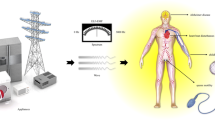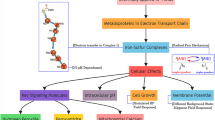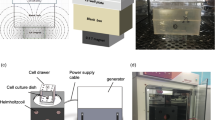Abstract
Epidemiological studies suggest a correlation between exposure to low-level extremely low-frequency (ELF) magnetic fields (MF) and certain cancers and neurodegenerative diseases. Experimental studies have not provided any mechanism for such effects, although at flux density levels significantly higher than the ones encountered in epidemiological studies, radical homoeostasis and levels of stress response proteins can be affected. Here, we report on the influence of MF exposure (50-Hz sine wave; 1 h; 0.025–0.10 mT; vertical or horizontal MF exposure direction) on different cellular parameters (proliferation, cell cycle distribution, superoxide radical anion, and HSP70 protein levels) in the human leukaemia cell line K562. The positive control heat treatment (42°C, 1 h) did not affect either cell proliferation or superoxide radical anion production but caused accumulation of cells in the G2 phase and increased the stress protein HSP70. MF exposure (0.10 mT, 1 h) did not affect either cell cycle kinetics or proliferation. Both vertical and horizontal MF exposures for 1 h caused significantly and transiently increased HSP70 levels (>twofold), at several flux densities, compared to sham controls and also compared to heat treatment. This exposure also increased (30–40%) the levels of the superoxide radical anion, comparable to the positive control PMA. Addition of free radical scavengers (melatonin or 1,10-phenantroline) inhibited the MF-induced increase in HSP70. In conclusion, an early response to ELF MF in K562 cells seems to be an increased amount of oxygen radicals, leading to HSP70 induction. Furthermore, the results suggest that there is a flux density threshold where 50-Hz MF exerts its effects on K562 cells, at or below 0.025 mT, and also that it is the MF, and not the induced electric field, which is the active parameter.





Similar content being viewed by others
References
Balcer-Kubiczek EK, Harrison GH, Davis CC, Haas ML, Koffman BH (2000) Expression analysis of human HL60 cells exposed to 60 Hz square- or sine-wave magnetic fields. Radiat Res 153:670–678
Barlow-Walden LR, Reiter RJ, Abe M, Pablos M, Menendez-Pelaez A, Chen LD, Poeggeler B (1995) Melatonin stimulates brain glutathione peroxidase activity. Neurochem Int 26:497–502
Bernardini C, Zannoni A, Turba ME, Bacci ML, Forni M, Mesirca P, Remondini D, Casellani G, Bersani F (2007) Effects of 50 Hz sinusoidal magnetic fields on Hsp27, Hsp70, Hsp90 expression in porcine aortic endothelial cells (PAEC). Bioelectromagnetics 28:231–237
Blackman CF, Benane SG, House DE (2001) The influence of 1.2 microT, 60 Hz magnetic fields on melatonin- and tamoxifen-induced inhibition of MCF-7 cell growth. Bioelectromagnetics 22:122–128
Bradford MM (1976) A rapid and sensitive method for the quantitation of microgram quantities of protein utilizing the principle of protein-dye binding. Anal Biochem 72:248–254
Byus CV, Pieper SE, Adey WR (1987) The effects of low-energy 60-Hz environmental electromagnetic fields upon the growth-related enzyme ornithine decarboxylase. Carcinogenesis 8:1385–1389
Carmody S, Wu XL, Lin H, Blank M, Skopicki H, Goodman R (2000) Cytoprotection by electromagnetic field-induced hsp70: a model for clinical application. J Cell Biochem 79:453–459
Chen G, Upham BL, Sun W, Chang CC, Rothwell EJ, Chen KM, Yamasaki H, Trosko JE (2000) Effect of electromagnetic field exposure on chemically induced differentiation of friend erythroleukemia cells. Environ Health Perspect 108:967–972
Coulton LA, Harris PA, Barker AT, Pockley AG (2004) Effect of 50 Hz electromagnetic fields on the induction of heat-shock protein gene expression in human leukocytes. Radiat Res 161:430–434
Dröge W (2002) Free radicals in the physiological control of cell function. Physiol Rev 82:47–95
Fiorani M, Cantoni O, Sestili P, Conti R, Nicolini P, Vetrano F, Dacha M (1992) Electric and/or magnetic field effects on DNA structure and function in cultured human cells. Mutat Res 282:25–29
Frahm J, Lantow M, Lupke M, Weiss DG, Simko M (2006) Alteration in cellular functions in mouse macrophages after exposure to 50 Hz magnetic fields. J Cell Biochem 99:168–177
George I, Geddis MS, Lill Z, Lin H, Gomez T, Blank M, Oz MC, Goodman R (2008) Myocardial function improved by electromagnetic field induction of stress protein hsp70. J Cell Physiol 216:816–823
Gerber E, Bredy A, Kahl R (1996) Ortho-phenanthroline modulates enzymes of cellular energy metabolism. Toxicology 110:85–93
Girgert R, Schimming H, Korner W, Grundker C, Hanf V (2005) Induction of tamoxifen resistance in breast cancer cells by ELF electromagnetic fields. Biochem Biophys Res Commun 336:1144–1149
Girgert R, Grundker C, Emons G, Hanf V (2008) Electromagnetic fields alter the expression of estrogen receptor cofactors in breast cancer cells. Bioelectromagnetics 29:169–176
Goodman R, Blank M (2002) Insights into electromagnetic interaction mechanisms. J Cell Physiol 192:16–22
Gorman AM, Heavey B, Creagh E, Cotter TG, Samali A (1999) Antioxidant-mediated inhibition of the heat shock response leads to apoptosis. FEBS Lett 445:98–102
Gottwald E, Sontag W, Lahni B, Weibezahn KF (2007) Expression of HSP72 after ELF-EMF exposure in three cell lines. Bioelectromagnetics 28:509–518
Harland JD, Liburdy RP (1997) Environmental magnetic fields inhibit the antiproliferative action of tamoxifen and melatonin in a human breast cancer cell line. Bioelectromagnetics 18:555–562
Harris PA, Lamb J, Heaton B, Wheatley DN (2002) Possible attenuation of the G2 DNA damage cell cycle checkpoint in HeLa cells by extremely low frequency (ELF) electromagnetic fields. Cancer Cell Int 2:3
Helmbrecht K, Zeise E, Rensing L (2000) Chaperones in cell cycle regulation and mitogenic signal transduction: a review. Cell Prolif 33:341–365
IARC (2002) Non-ionizing radiation, part 1: static and extremely low-frequency (ELF) electric and magnetic fields. IARC Monogr Eval Carcinog Risks Hum 80:1–395
Ishido M, Nitta H, Kabuto M (2001) Magnetic fields (MF) of 50 Hz at 1.2 microT as well as 100 microT cause uncoupling of inhibitory pathways of adenylyl cyclase mediated by melatonin 1a receptor in MF-sensitive MCF-7 cells. Carcinogenesis 22:1043–1048
Jin M, Blank M, Goodman R (2000) ERK1/2 phosphorylation, induced by electromagnetic fields, diminishes during neoplastic transformation. J Cell Biochem 78:371–379
Korzh-Sleptsova IL, Lindström E, Hansson Mild K, Berglund A, Lundgren E (1995) Low frequency MFs increased inositol 1, 4, 5-trisphosphate levels in the Jurkat cell line. FEBS Lett 359:151–154
Kuhl NM, Rensing L (2000) Heat shock effects on cell cycle progression. Cell Mol Life Sci 57:450–463
Lange S, Richard D, Viergutz T, Kriehuber R, Weiss DG, Simkó M (2002) Alterations in the cell cycle and in the protein level of cyclin D1, p21CIP1, and p16INK4a after exposure to 50 Hz MF in human cells. Radiat Environ Biophys 41:131–137
Lange S, Viergutz T, Simkó M (2004) Modifications in cell cycle kinetics and in expression of G1 phase-regulating proteins in human amniotic cells after exposure to electromagnetic fields and ionizing radiation. Cell Prolif 37:337–349
Lin H, Opler M, Head M, Blank M, Goodman R (1997) Electromagnetic field exposure induces rapid, transitory heat shock factor activation in human cells. J Cell Biochem 66:482–488
Lin H, Blank M, Goodman R (1999) A magnetic field-responsive domain in the human HSP70 promoter. J Cell Biochem 75:170–176
Lupke M, Rollwitz J, Simko M (2004) Cell activating capacity of 50 Hz magnetic fields to release reactive oxygen intermediates in human umbilical cord blood-derived monocytes and in Mono Mac 6 cells. Free Radic Res 38:985–993
Lupke M, Frahm J, Lantow M, Maercker C, Remondini D, Bersani F, Simko M (2006) Gene expression analysis of ELF-MF exposed human monocytes indicating the involvement of the alternative activation pathway. Biochim Biophys Acta 1763:402–412
Malagoli D, Lusvardi M, Gobba F, Ottaviani E (2004) 50 Hz magnetic fields activate mussel immunocyte p38 MAP kinase and induce HSP70 and 90. Comp Biochem Physiol C Toxicol Pharmacol 137:75–79
Marshall KA, Reiter RJ, Poeggeler B, Aruoma OI, Halliwell B (1996) Evaluation of the antioxidant activity of melatonin in vitro. Free Radic Biol Med 21:307–315
McDuffee AT, Senisterra G, Huntley S, Lepock JR, Sekhar KR, Meredith MJ, Borrelli MJ, Morrow JD, Freeman ML (1997) Proteins containing non-native disulfide bonds generated by oxidative stress can act as signals for the induction of the heat shock response. J Cell Physiol 171:143–151
Morimoto RI (1998) Regulation of the heat shock transcriptional response: cross talk between a family of heat shock factors, molecular chaperones, and negative regulators. Genes Dev 12:3788–3796
Mullins JM, Penafiel LM, Juutilainen J, Litovitz TA (1999) Dose–response of electromagnetic field-enhanced ornithine decarboxylase activity. Bioelectrochem Bioenerg 48:193–199
Nollen EA, Morimoto RI (2002) Chaperoning signaling pathways: molecular chaperones as stress-sensing ‘heat shock’ proteins. J Cell Sci 115:2809–2816
Nordenson I, Mild KH, Andersson G, Sandstrom M (1994) Chromosomal aberrations in human amniotic cells after intermittent exposure to fifty hertz magnetic fields. Bioelectromagnetics 15:293–301
Ozturk G, Coskun S, Erbas D, Hasanoglu E (2000) The effect of melatonin on liver superoxide dismutase activity, serum nitrate and thyroid hormone levels. Jpn J Physiol 50:149–153
Palumbo R, Capasso D, Brescia F, Mita P, Sarti M, Bersani F, Scarfi MR (2006) Effects on apoptosis and reactive oxygen species formation by Jurkat cells exposed to 50 Hz electromagnetic fields. Bioelectromagnetics 27:159–162
Papp E, Nardai G, Soti C, Csermely P (2003) Molecular chaperones, stress proteins and redox homeostasis. Biofactors 17:249–257
Pipkin JL, Hinson WG, Young JF, Rowland KL, Shaddock JG, Tolleson WH, Duffy PH, Casciano DA (1999) Induction of stress proteins by electromagnetic fields in cultured HL-60 cells. Bioelectromagnetics 20:347–357
Rodriguez de la Fuente AO, Aleocer-Gonzalez JM, Heredia-Rojas JA, Balderas-Candanosa I, Rodriguez-Flora LE, Rodriguez-Padilla C, Tamez-Guerra RS (2009) Effect of 60 Hz electromagnetic fields on the activity of hsp70 promoter: an in vitro study. Cell Biol Int 33:419–423
Rollwitz J, Lupke M, Simkó M (2004) Fifty-hertz magnetic fields induce free radical formation in mouse bone marrow-derived promonocytes and macrophages. Biochim Biophys Acta 1674:231–238
Simkó M (2004) Induction of cell activation processes by low frequency electromagnetic fields. ScientificWorldJournal 4(Suppl 2):4–22
Simkó M, Mattsson MO (2004) Extremely low frequency electromagnetic fields as effectors of cellular responses in vitro: possible immune cell activation. J Cell Biochem 93:83–92
Tokalov SV, Gutzeit HO (2003) The heat shock-induced cell cycle arrest is attenuated by weak electromagnetic fields. Cell Prolif 36:101–111
Tokalov SV, Gutzeit HO (2004) Weak electromagnetic fields (50 Hz) elicit a stress response in human cells. Environ Res 94:145–151
Valberg PA, Kavet R, Rafferty CN (1997) Can low-level 50/60 Hz electric and magnetic fields cause biological effects? Radiat Res 148:2–21
Valtersson U, Hansson Mild K, Mattsson MO (1997) Ornithine decarboxylase activity and polyamine levels are different in Jurkat and CEM-CM3 cells after exposure to a 50 Hz magnetic field. Bioelectrochem Bioenerg 43:169–172
Verheyen GR, Pauwels G, Verschaeve L, Schoeters G (2003) Effect of coexposure to 50 Hz magnetic fields and an aneugen on human lymphocytes, determined by the cytokinesis block micronucleus assay. Bioelectromagnetics 24:160–164
Wolf FI, Torsello A, Tedesco B, Fasanella S, Boninsegna A, D’Ascenzo M, Grassi C, Azzena GB, Cittadini A (2005) 50-Hz extremely low frequency electromagnetic fields enhance cell proliferation and DNA damage: possible involvement of a redox mechanism. Biochim Biophys Acta 1743:120–129
Yoshizawa H, Tsuchiya T, Mizoe H, Ozeki H, Kanao S, Yomori H, Sakane C, Hasebe S, Motomura T, Yamakawa T, Mizuno F, Hirose H, Otaka Y (2002) No effect of extremely low-frequency magnetic field observed on cell growth or initial response of cell proliferation in human cancer cell lines. Bioelectromagnetics 23:355–368
Zwirska-Korczala K, Jochem J, Adamczyk-Sowa M, Sowa P, Polaniak R, Birkner E, Latocha M, Pilc K, Suchanek R (2005) Effect of extremely low frequency of electromagnetic fields on cell proliferation, antioxidative enzyme activities and lipid peroxidation in 3T3-L1 preadipocytes—an in vitro study. J Physiol Pharmacol 56(Suppl 6):101–108
Acknowledgments
Parts of the study were financed by grants from Deutsche Forschungsgemeinschaft (Mercator Professorship to MOM) and by Bundesamt für Strahlenschutz.
Author information
Authors and Affiliations
Corresponding author
Rights and permissions
About this article
Cite this article
Mannerling, AC., Simkó, M., Mild, K.H. et al. Effects of 50-Hz magnetic field exposure on superoxide radical anion formation and HSP70 induction in human K562 cells. Radiat Environ Biophys 49, 731–741 (2010). https://doi.org/10.1007/s00411-010-0306-0
Received:
Accepted:
Published:
Issue Date:
DOI: https://doi.org/10.1007/s00411-010-0306-0




